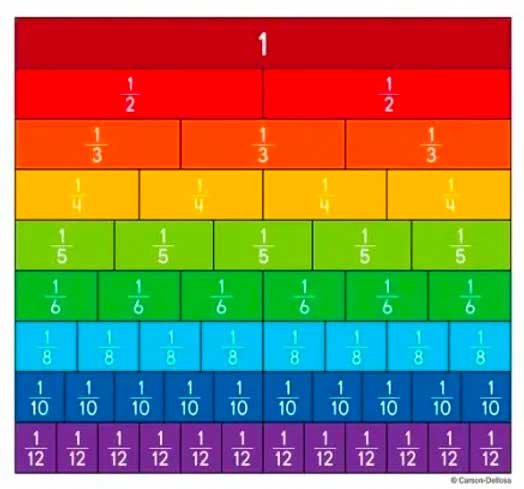What the fraction? A story of two operations
Fractions! We either love to love or love to hate them. Personally, I really enjoy fractions, and I enjoy teaching them even more. But this wasn't always the case.
Years back when I was still a full-time classroom teacher, the topic of fractions would illicit groans of despair from not only the students but also the teachers. This was because we knew what a struggle it was going to be to support the students and help them to feel confident with their understanding in this area. Like most teachers who have gone through the Australian education system, I learned fractions very procedurally, and as a teacher, I started my journey teaching much the same way. However, I was also keenly aware of my own struggles with mathematics and knew that there had to be a better way. So I searched.
Much like The Borg's attempts to assimilate Captain Piccard into their collective, my initial attempts were futile. I scrolled through many open market sources for some inspiration and cool ways that I could make the topic more relatable. I introduced obvious mnemonics like KCF (keep, change flip), when dividing fractions and tried to attach it to a story to try to help students to remember it. I got kids to make fraction walls by dividing paper.
I drew pictures, told tales, and used creative worksheets with games and artwork but still, they struggled. I reached a point where I thought "Maybe fractions is just one of those topics that some people will always struggle with", but then, I was introduced to something that would change the way that I, as a secondary trained teacher, would view fractions, and in fact, mathematics in general, forever...*dramatic pause*...the humble area model! Don't get me wrong, I knew of the area model, but I had always thought that by the time kids got to secondary school, they had moved beyond that approach...boy was I wrong!
Area models showing the multiplication 16 x 25
The year that I started at AMSI, was the year that things changed for me. Suddenly, I had the space and freedom to explore mathematics at a deep level and I was introduced to the term conceptual mathematics. This idea resonated with me so deeply, that I just had to know more. I felt like this was what I had been missing in my own mathematical journey and the creative possibilities seemed endless.
But it wasn't easy because I soon realised, that when one has spent their life learning one way, it's difficult to learn a new way. I still remember my friend and colleague at the time, Helen, trying intently to teach me fraction multiplication and division using an area model. I wrestled with the ideas and tried desperately to integrate them into my current schema, but it was tough. As soon as I felt like I understood it, I would revisit it without the support and it would be gone. But then one day, a revelation! I was having a casual conversation with one of my other colleagues Anna and explaining my trouble with fraction operations. She put it in such simple terms, that I have never forgotten it. She said, "Nadia, it's all about the language". Anna went on to encourage me to remember the fundamentals of multiplication and division. Multiplication being 'groups of' and division being 'how many'.
So let us take a look.
Start by imagining 3 x 4. If we think about what it means to multiply three by four, we are really asking what are four 'groups of' three, or what do three rows of four columns make? The operative word being 'of'. Now let's transfer this understanding to fractions.
I want to perform the following calculation:
Here's how the calculation would usually go:
The million-dollar question though is, why? Remember, leading up to this point students have been learning how to add and subtract fractions and in this process, they need to find common denominators. When multiplying fractions however, the process has completely changed. Aside from this, prior to being introduced to fraction multiplication, they have been practicing whole number multiplication where the product of the multiplication is larger. Here our product is smaller. If students understood fractions before, or just maths in general, it would be at this point that things start to unravel. I know it did for me. This whole process just does not make sense my guy!
So, let me introduce you to the why and show you a way that you can help students to visualise what is really going on.
Take our fraction multiplication again, but this time, let's change the language and say we want to find:
This is what we are attempting to find. We are trying to figure out what one-half of one-quarter would be. We can start by drawing our quarter. Here is what one-quarter could look like:
Now, what would one-half of one-quarter be?
I sometimes, aka always, like to introduce this as a story. Here's a simple one...
Mum baked a yummy chocolate cake. When me and my three brothers asked for a slice Mum said that she was saving some for dessert, but that we could share half of the cake. How much of the whole cake do we get?
Each person gets one-eighth of the whole chocolate cake.
Keep in mind that commutativity means that regardless of the order of the two factors, the product of any multiplication will be the same. This applies to fractions as well. Challenging the students with this idea is important.
Now on to division my friends, because when this guy is introduced to fraction operations, stuff starts to get real. Here's how the process of fraction division would generally go:
I would like to divide one-half by one-sixth.
The first step in dividing two fractions is to find the reciprocal of the divisor and then multiply this by the dividend. This is because the division is the inverse of multiplication, so I guess it makes sense, but only if you understand multiplication first right? Either way, here's how it would go:
Ok, shut the front door everyone!! How does the division of two unit fractions make a whole number?? When we divide things they get smaller right?? Well, apparently wrong. Maths has proven once again what a slippery little sucker it is and destroyed people's will to live...through maths class at least...or has it!!
Hold onto your hats friends because I'm about to tell you why, and how, this makes total sense.
Back to our division:
Remember our language lesson? Let's change the division sign to its worded explanation of 'how many'.
Now let's show this using an area model.
Is the reason obvious yet? Let's keep going...
There are three one-sixths in one-half you guys!! That's why one half-divided by one-sixth is 3; it's actually three 1/6's!! 😱
My advice is to use this language whenever teaching fractions, both for the questioning and in the solution. Then,continue to help the students to recognise the process through repeated exposure to the concrete and conceptual approach and gently remove the training wheels.
Here's what I am NOT saying! Are you ready?
I'm not saying that I think the students should always solve fraction operations using this approach. The idea is that we use it as a scaffold to help them understand why the process works and then see if they can make the connections to the process on their own. How I have done it in the past, is to give the students a few simple examples, allow them to solve them using the paper folding, and then ask them, "Hey guys, do you notice anything about the solution and how it compares to the problem?". A lot of students may notice the 'shortcut' straight away, but if they don't, then you can ask them prompting questions to help guide their thinking. The best-case scenario is that they have that aha moment when it comes to making connections and that way, they will have a MUCH better chance of remembering the process down the track.
Try these simple ones to get started:
Fraction operations can get trickier to show using folded paper so be careful to try before you teach. I have been caught out many a time which is perfectly ok, but if the idea is to lead students seamlessly to the process, then ensure that the problems you select provide a simple and clear path to this destination.














